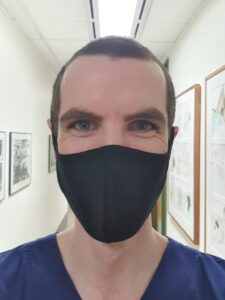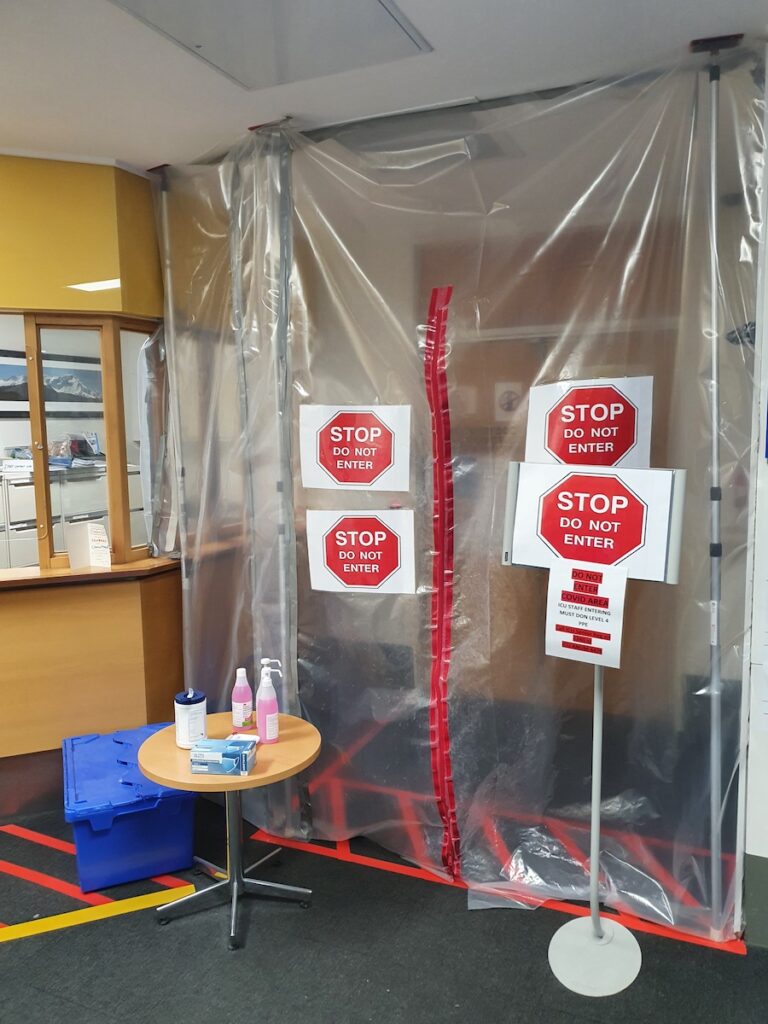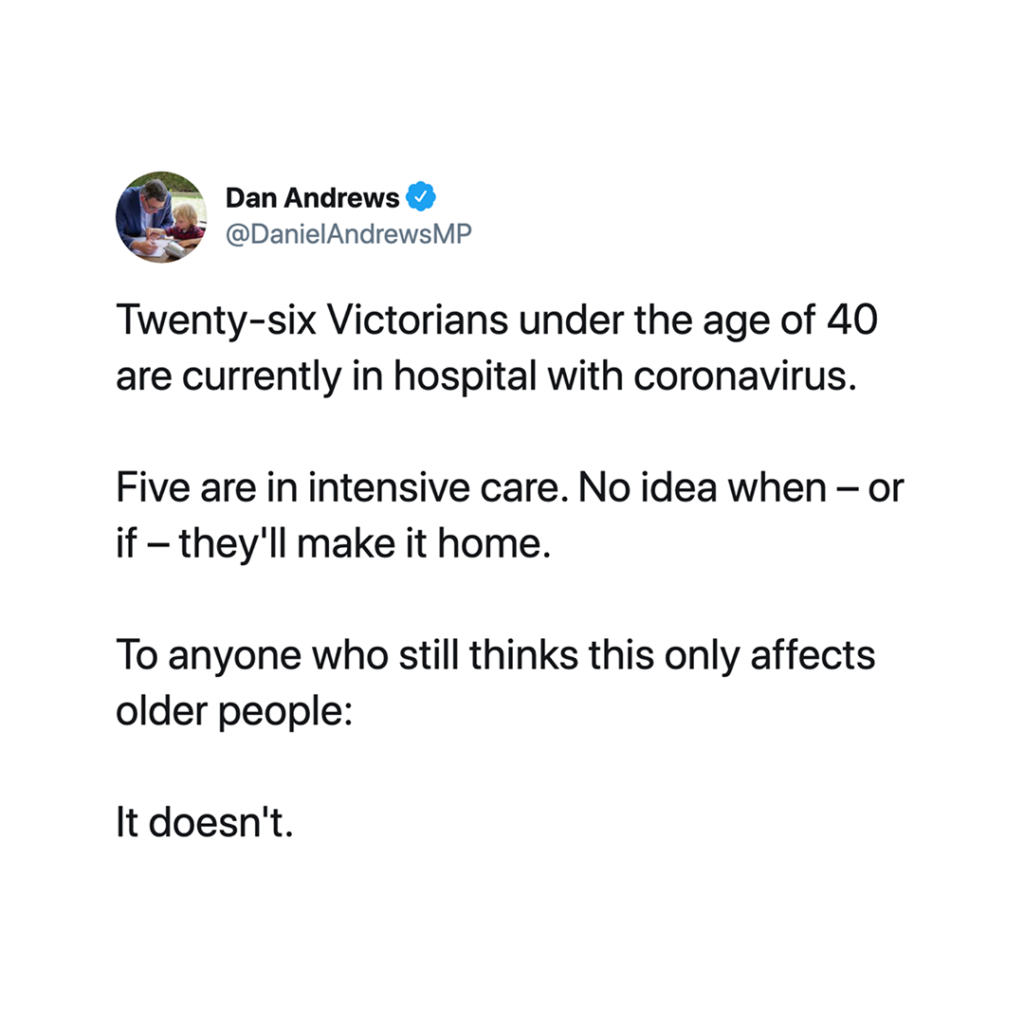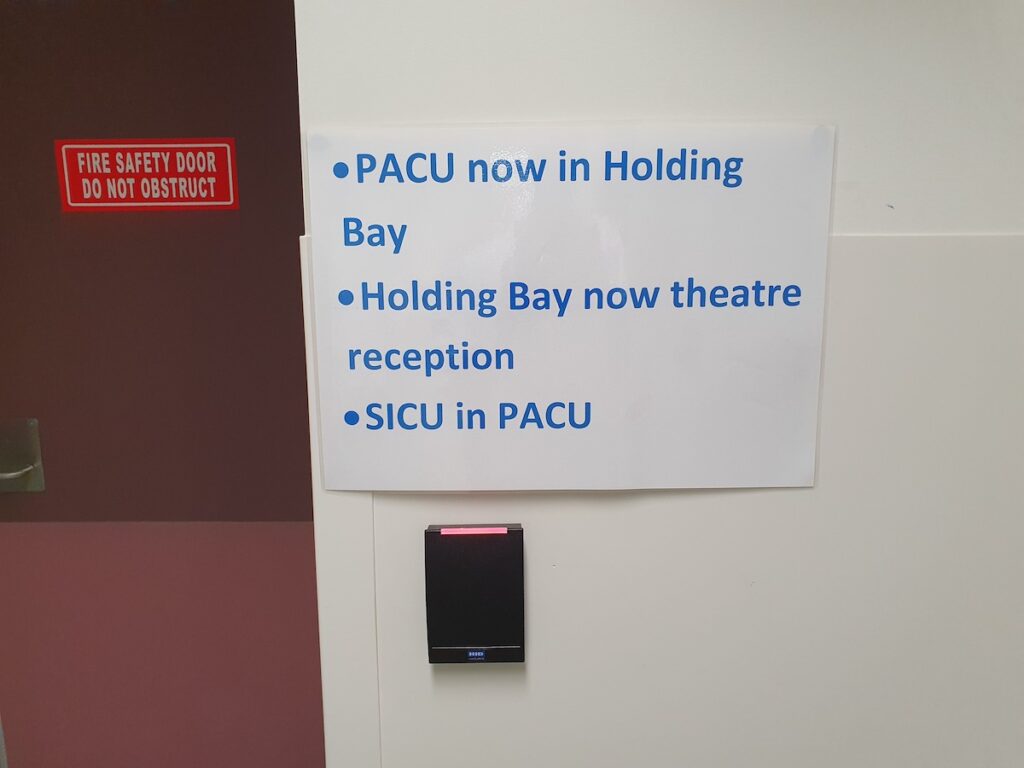Dr Richard Seglenieks is an Anaesthetic Registrar at St Vincent’s Hospital Melbourne. Here, he provides some additional reflections following on from a previous post in June 2020.

I have found living and working through the COVID-19 pandemic stressful, and I know many of you have too. Out in the community, there are countless others who have found it difficult in a range of different ways. Stable jobs have vanished; successful businesses have crumbled; carefully-crafted plans have been destroyed; hopes and dreams have been ripped away. This is not like any other health scare in recent years – it was sudden and unexpected, and it has dramatically affected our way of life. This is the reality for us, our families, our friends, our colleagues. Our neighbours. Our patients. Strangers and acquaintances. Nobody has been completely spared.
Much has happened since I wrote about my experience as an anaesthetic trainee in the time of COVID-19 back in June1. When I submitted that piece, it appeared that Australia and New Zealand both had the pandemic under control, with daily case numbers in the single- or low-double-digits for the whole of Australia and single-digits for New Zealand. While our unexpected success was pleasantly surprising, there was still an overwhelming sense of uncertainty about what lay ahead. Given the nature of the infection, particularly its ease of transmission and potentially long asymptomatic period, as well as the extensive prevalence around the world, the risk of further outbreaks was always high.
The situation has unfortunately progressed dramatically here in Melbourne. We saw several weeks of triple-digit new daily cases with over 600 in hospital, more than 30 in ICU and nearly 500 deaths2. Restrictions have also progressed, with Melbourne under Stage 4 Restrictions and the rest of Victoria at Stage 3. Masks are mandatory in public and even interstate (let alone international) travel is out. Most remarkably, there is a curfew in place in Melbourne from 8pm to 5am, with the only exceptions being for work, medical care and caregiving.
While the pandemic has impacted everyone, these effects are not universal or evenly distributed. In general, younger people have and will suffer greater impacts in almost every way except for the direct health effects for those who are infected. As an overall younger group, trainees are likely to suffer greater negative effects from the pandemic than fellows – though there are of course potential exceptions to this (e.g. a new fellow with predominantly private practice). Some effects are specific to anaesthetic trainees and some are more broadly applicable to ‘young people’, which in this context is probably a spectrum with impacts that mostly gradually diminish from about age 16 to 35. I acknowledge that most of us are in a far better overall position than those who are younger than us and those working outside of healthcare.
Training
At work, we are doing fewer cases overall, with a different case mix, and more of us are working in ICU. Redeployment to ICU also impacts trainees continuing to work in anaesthesia, as they need to undertake a greater proportion of after-hours work to maintain required staffing levels. These changes affect our ability to meet volume of practice (VOP) requirements, complete workplace based assessments (WBA) and sign off our specialised study units (SSU).
There are additional demands placed on us, such as PPE training, simulations, learning guidelines and refreshing ICU knowledge, which further distract from our usual focus. Many of us are working at reduced efficiency, through a combination of stress, anxiety, prolonged exam study, and the additional cognitive load of altered routines. The formats and content of our teaching and meetings have changed, while access to courses (EMAC, ALS, exam courses, etc.) and conferences is limited.
Most of our training requirements are unchanged. The main differences are increased flexibility in deferring some requirements to the next training period (thus increasing the burden of requirements in following years), the removal of a WBA ‘run rate’ requirement, and the ability to count local events and webinars towards the requirement to attend regional or greater conferences3.
I think it’s really important to highlight that disruptions this year will have flow-on effects in the next year or two for most trainees. This is not necessarily a transient setback.

Exams
Delays, changes and uncertainty around exams are the greatest source of stress for many trainees. Given the dynamic and variable nature of restrictions on travel and large gatherings across New Zealand and each Australian state and territory, plans have changed multiple times regarding the exam dates and locations. The interval between the written and viva components of the exams has now been extended to 7 or 8 months – a long time to maintain peak knowledge across a broad curriculum. For the primary exam, Melbourne-based candidates have an additional 6 week delay. Other changes include written exams in Melbourne being decentralised, and removal of the medical vivas from the fellowship exam.
ANZCA has assured candidates of multiple contingency plans given the dynamic situation, however many trainees have been frustrated and distressed by the uncertainty and sometimes limited communication of these plans. Many trainees are relieved that the college’s initial position ruling out electronic or videoconferenced exams this year (due to justifiable concerns regarding the reliability and quality of online platforms) has been revisited, and “hybrid or fully online options are being explored and developed”4. Currently, it’s unclear exactly what format the vivas will take, with the final decision depending on readiness of the online platforms and the restrictions in place at the time.
There are still some major concerns among trainees – too many to list here, but they include the potential need to resit the entire exam if unable to sit the viva on the designated date due to COVID-19 infection, possible symptoms, or being furloughed due to a high risk exposure.
Health
The pandemic presents unique health risks – both to physical and mental health. We have concerns for ourselves but also for our family, friends and colleagues. We are ourselves at high risk by the nature of our work: in Victoria, more than 2,500 healthcare workers have tested positive to COVID-19, representing about 14% of the state’s total cases5, with 70-80% suspected to have been transmitted at work6.
Trainees are not immune to this risk, with numerous stories of young previously health people suffering severe illness and even dying from COVID-19, and evolving evidence of potential long-term impacts following infection, including after minor and asymptomatic cases.

Tweet from Premier of Victoria, Daniel Andrews, 29 July 2020
Restrictions and concern for potentially contracting or spreading infection prevent some of us from engaging with our usual hobbies or physical activities. With gyms and sporting venues closed, and exercise limited to a 5km radius from home, I would be surprised if many people aren’t more sedentary than usual. I’m sure studying for a major exam for an additional six months can’t be healthy either.
Perhaps of greater concern on a societal level are the mental health impacts of the pandemic and lockdown. Australians have also reported high rates of stress, anxiety and depression during the pandemic7. Younger people are at particularly high risk of mental health issues. The figures were already concerning pre-pandemic but rates of severe psychological distress in young Australians have seen relative increases of 50-60% over the last 3 years8. Isolation, loneliness, and strained relationships are also serious risks. Evidence indicates that young people are more lonely than other age groups9, though healthcare workers are partially protected by still going to work and interacting with our colleagues and patients on a regular basis.
As doctors, we face unique challenges that may impact our mental health. Caring for patients with COVID-19 can be an exhausting, confronting and overwhelming experience, particularly when our patients suffer serious morbidity or mortality. Doctors also tend not to seek psychological help when we should, even though evidence indicates a 10% risk of longer-term mental health issues for front-line health workers in a pandemic10.
Financial
Evidence, past experience and expert opinions suggest that younger people will bear the brunt of the economic impacts, with lifelong effects11. Without the financial security that many of our older counterparts have built over years of economic growth, young Australians are particularly vulnerable to economic downturns.
Young people already had disproportionately high levels of unemployment and under-employment before the pandemic, and this trend has accelerated in recent months due to job losses in industries they are over-represented in, such as hospitality and retail12. Loss of work & training during formative years can have long-term or permanent effects. Affected individuals may miss the opportunity to develop crucial skills and experience that will limit their career prospects and earning potential12. While we are relatively protected from this as doctors, our partners, family and friends may not be.
Other
Trainees have also experienced a range of other impacts, including delayed and modified job application processes, altered fellowship plans for this year and next, and changes to planned rotations (particularly those moving to/from rural locations & ICU).
Silver Linings
One possible positive outcome from the pandemic is the reframing of calling in sick, from questioning ‘am I too sick to be physically able to work?’ to ‘is the risk of infecting colleagues or patients too great?’. This could help end the pervasive culture of presenteeism (i.e. working while sick) in medicine, though there have been mixed reports about how the pandemic has actually impacted this practice and whether the pendulum has swung too far in the opposite direction13.
The capacity for our usually reasonably static systems to make radical changes has been really impressive and refreshing. In our hospital, for example, our main ICU has become a COVID-19 unit, with the non-COVID-19 ICU patients now cared for in what was our recovery room, which has in turn shifted to our holding bay. We have seen rapid development and evolution of guidelines over the course of the pandemic as new evidence emerges and our understanding grows. Our departmental meetings have shifted to Zoom, and while this has some downsides, I think these are outweighed by the ability to dial in from the car, the anaesthetic room, or home.

There’s a renewed sense of camaraderie among staff in the face of new challenges – it’s great to see people pulling together through tough times. We are also better at consistently and appropriately using PPE in clinical settings. Pre-pandemic, many clinicians wouldn’t have thought twice about performing airway interventions or other procedures without a mask and eye protection; now, we are wearing masks and goggles or face shields in all clinical areas and often additional barriers for aerosol-generating procedures.
A number of departments have started up new welfare and wellbeing initiatives to help support staff through these challenging times, which are appreciated both for their substance and the intention. Lastly, dramatic reductions in traffic have made commuting to work a breeze – driving to work makes me feel like I’m back in Adelaide!
Dr Richard Seglenieks
Anaesthetic Registrar, St. Vincent’s Hospital Melbourne
An abbreviated version of this article will be published in the September issue of the ANZCA Bulletin.
References
- Seglenieks R. COVID-19 as an Anaesthetic Trainee. Geoffrey Kaye Museum Blog. June 2020. https://www.geoffreykayemuseum.org.au/covid-19-as-an-anaesthetic-trainee/
- Victorian State Government Department of Health and Human Services. Coronavirus (COVID-19) daily update. August 2020. https://www.dhhs.vic.gov.au/coronavirus-covid-19-daily-update
- COVID-19 – guidance on completing ANZCA requirements. August 2020. https://www.anzca.edu.au/education-training/covid-19-trainee-info/covid-19-guidance-on-anzca-assessments
- Beavis V. Update on ANZCA exams. 10 August 2020. [email]
- Hendrie D. Why are so many Victorian healthcare workers contracting COVID-19?. RACGP newsGP. August 2020. https://www1.racgp.org.au/newsgp/clinical/why-are-so-many-victorian-healthcare-workers-contr
- Scott S, Lloyd M. About ’70 to 80pc’ of Victorian healthcare workers with COVID-19 caught it at work, Government reveals. ABC News. August 2020. https://www.abc.net.au/news/2020-08-25/health-workers-covid-coronavirus-case-numbers-victoria/12582468
- COVID-19 triggers dive in mental health. August 2020. https://www.ausdoc.com.au/news/covid19-triggers-dive-mental-health
- Australian National University. Millennial mental health toll spikes during Covid. May 2020. https://www.anu.edu.au/news/all-news/millennial-mental-health-toll-spikes-during-covid
- Willis O, Cockburn P. How young people are adapting to the challenges of living through a July 2020. https://www.abc.net.au/news/health/2020-07-12/how-young-people-cope-and-adapt-during-coronavirus-pandemic/12437896
- Tuohy W. Not ‘heroes’ nor martyrs, doctors’ mental health also needs support. The Age. August 2020. https://www.theage.com.au/national/victoria/not-heroes-nor-martyrs-doctors-mental-health-also-needs-support-20200814-p55lur.html
- The Economic Impact Of COVID-19 On Young People. April 2020. https://www.npr.org/2020/04/27/846218124/the-economic-impact-of-covid-19-on-young-people
- Dimov S, King T, Shields M, Kavanagh A. The Young Australians Hit Hard During COVID-19. May 2020. https://pursuit.unimelb.edu.au/articles/the-young-australians-hit-hard-during-covid-19
- McCrossin K. COVID-19’s silver lining: ending presenteeism in medicine. MJA InSight+. August 2020. https://insightplus.mja.com.au/2020/31/covid-19s-silver-lining-ending-presenteeism-in-medicine/
